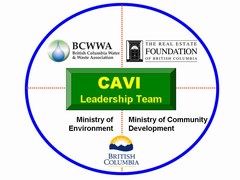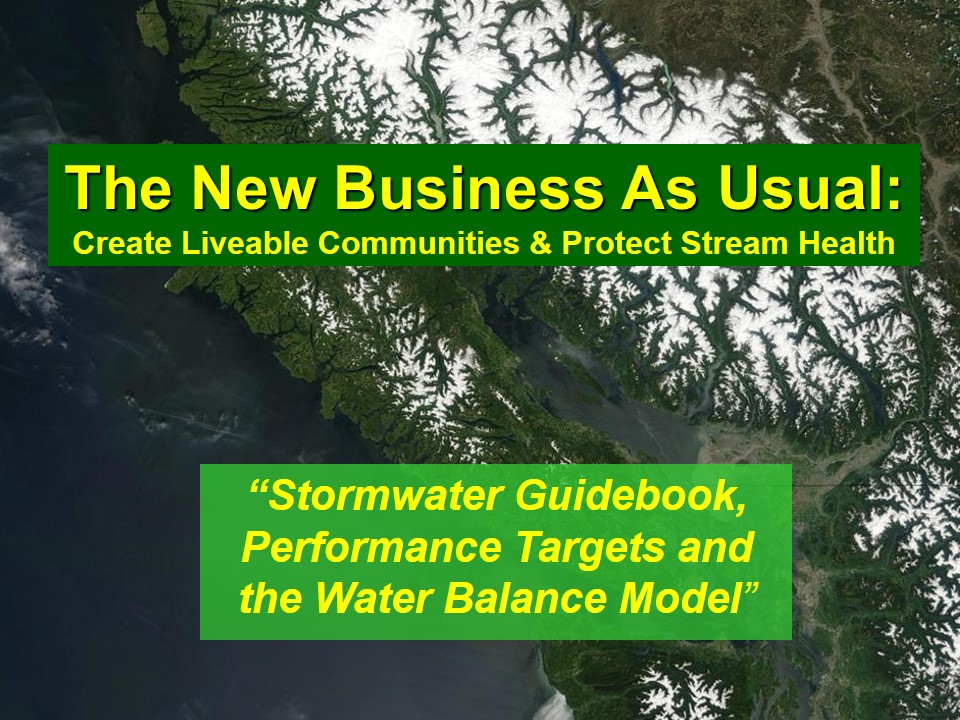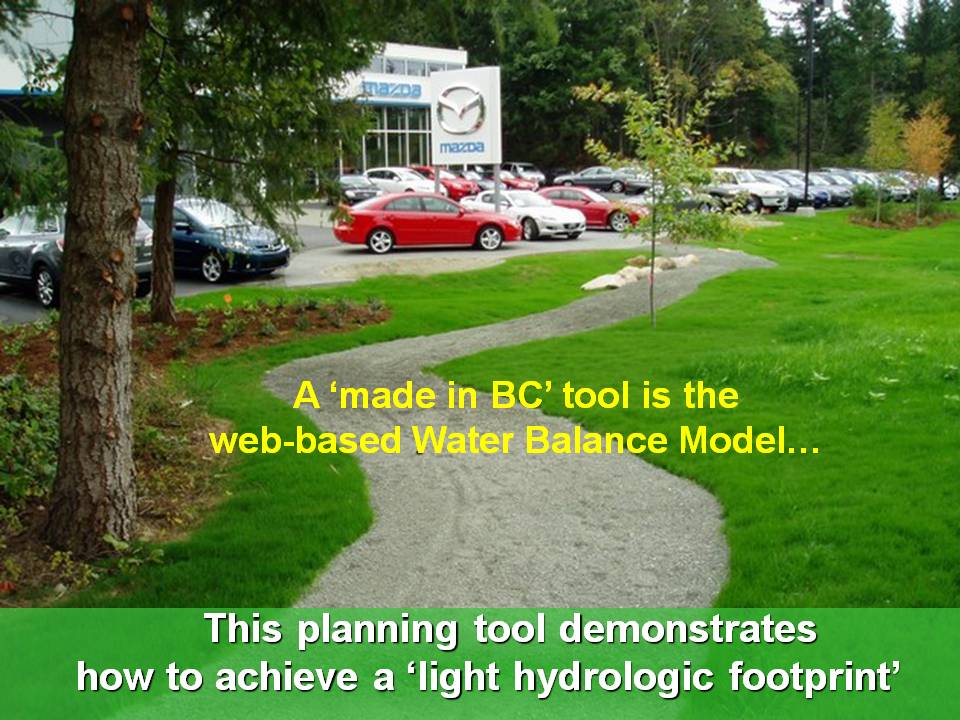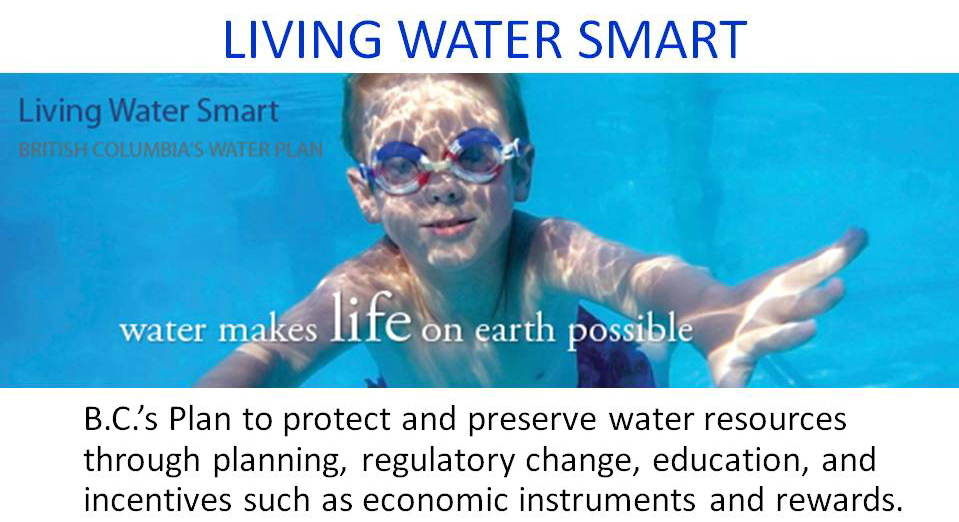Stormwater Guidebook, Performance Targets and the Water Balance Model: Connecting the Dots
The New Business As Usual: Integration of RAINwater Management with Land Development Practices
At the first in the 2008 Comox Valley Learning Lunch Seminar Series, hosted by the City of Courtenay and held in September 2008, Kim Stephens wrapped up the day by connecting the dots between the Stormwater Guidebook, performance targets and the  Water Balance Model. His introductory presentation followed a walkabout in east Courtenay and set the stage for the next two seminars in the series.
Water Balance Model. His introductory presentation followed a walkabout in east Courtenay and set the stage for the next two seminars in the series.
Kim Stephens is the Program Coordinator for the Water Sustainability Action Plan for Britsh Columbia; and the seminar team leader.
“The goal of the Learning Lunch Seminar Series is to inform and educate local government practitioners,” stated Kim Stephens. “The series is the first step in building a regional team approach…..so that there will be a common understanding and consistent messaging regarding on-the-ground expectations for rainwater management and green infrastructure.”
PowerPoint Presentation
The slide presentation by Kim Stephens can be viewed by clicking on The New Business As Usual: Stormwater Guidebook, Performance Targets and Water Balance Model.
Key message: the Stormwater Guidebook pioneered development of a performance target methodology to achieve rainwater runoff capture; and the Water Balance Model was developed as an extension of the Guidebook.
Comox Valley Learning Lunch Seminar #1
Seminar #1 was introductory in scope, with the unifying theme being the evolution of drainage practices over the past two decades. For the complete story about the September 2008 seminar, click on Create Liveable Communities & Protect Stream Health: To get to the big picture, it starts with the smallest pieces.
“By placing the spotlight on the east Courtenay area, this helped seminar participants understand why drainage practices comprise a continuum of paradigms, and communities progress at different rates along the continuum,” explained Derek Richmond, Manager of Engineering for the City of Courtenay.
Links to YouTube Videos
To both provide a record of the day and capture the flavour of presentations at Seminar #1, video clips have been uploaded to YouTube. The maximum length is 10 minutes. The video of the presentation by Kim Stephens has been divided into three segments corresponding to the three parts of his presentation. To hear and learn more, click on the small images below to access the YouTube videos.
Stormwater Guidebook – Create a Legacy
In this first 10-minute segment, Kim Stephens set the scene for the current “Beyond the Guidebook” initiative. The emphasis was on key messages that capture the essence of the outcome-oriented Guidebook: “This is what we want.” stated Stephens.
“What we want are liveable communities and healthy streams,” elaborated Stephens. “In 2002, the Guidebook brought together Washington State biology and British Columbia hydrology. We are ready for the next big push.”
Beyond the Guidebook – Focus on Streams
In the second 10-minute segment, Kim explained how lessons learned since publication of the Guidebook in 2002 have been incorporated in the “Beyond the Guidebook” initiative: “What we once believed to be unachievable is now within our grasp. After six years, we have the benefits of lessons learned and experience gained. We can now relate how you manage volume on the site to what you see in the stream – the stream is the canary in the coal mine.”

Water Balance Model – Establish Targets
In the third 10-minuted segment, Kim introduced a generic application of the web-based Water Balance Model to illustrate how users of this decision support tool can readily quantify performance targets for rainwater runoff on a single family residential property.
“We are incorporating all the lessons we have learned to date,” explained Stephens. “After two years of work to install the QUALHYMO engine … the new Water Balance Model integrates the site with the watershed and the stream.”
About the Learning Lunch Series
The precedent-setting Vancouver Island Learning Lunch Seminar Series is part of the implementation program for Beyond the Guidebook: The New Business As Usual, This provincial initiative builds on the foundation provided by Stormwater Planning: A Guidebook for British Columbia, published in 2002. In 2008, participating Vancouver Island local governments represented some 250,000 people.
- The Cowichan Valley series was hosted by the Cowichan Valley Regional District and comprised a set of three sessions during the June – July 2008 period. To learn more, click on List of Waterbucket Stories About Cowichan Valley Series.
- The Comox Valley series was hosted by the City of Courtenay and comprised a set of three sessions during the September – November 2008 period. To learn more, click on List of Waterbucket Stories About Comox Valley Series.
The Learning Lunch Seminar Series promotes a consistent provincial approach to rainwater management and green infrastructure. It also adds depth to Living Water Smart, the Province’s plan for doing business differently….by encouraging water and land managers and users to make green choices that create liveable communities and protect stream health.
About CAVI
 The original CAVI Partnership comprised the British Columbia Water & Waste Association, the Real Estate Foundation of British Columbia, the provincial Ministries of Environment and Community Development, and the Green Infrastructure Partnership. For four years, CAVI was co-funded by the Province and the Real Estate for Foundation of British Columbia. Until 2010, the Water Sustainability Committee of the BCWWA was the managing partner and provided program delivery. In 2010, the committee morphed into the independent Partnership for Water Sustainability in BC. For more information about the CAVI initiative, click here
The original CAVI Partnership comprised the British Columbia Water & Waste Association, the Real Estate Foundation of British Columbia, the provincial Ministries of Environment and Community Development, and the Green Infrastructure Partnership. For four years, CAVI was co-funded by the Province and the Real Estate for Foundation of British Columbia. Until 2010, the Water Sustainability Committee of the BCWWA was the managing partner and provided program delivery. In 2010, the committee morphed into the independent Partnership for Water Sustainability in BC. For more information about the CAVI initiative, click here







